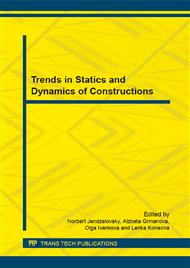[1]
Z. Kala, J. Gottvald, J. Stonis, A. Omishore, Sensitivity analysis of the stress state in shell courses of welded tanks for oil storage, Engineering Structures and Technologies, 6 (2014) 7–12.
DOI: 10.3846/2029882x.2014.957899
Google Scholar
[2]
ANSYS, Theory Release 14. 5, 2012, ANSYS Inc.
Google Scholar
[3]
J. Melcher, Z. Kala, M. Holicky, M. Fajkus, L. Rozlivka, Design characteristics of structural steels based on statistical analysis of metallurgical products, Journal of Constructional Steel Research, 60 (2004) 795–808.
DOI: 10.1016/s0143-974x(03)00144-5
Google Scholar
[4]
M.D. McKey, W.J. Conover, R.J. Beckman, A comparison of the three methods of selecting values of input variables in the analysis of output from a computer code, Technometrics, 21 (1979) 239–245.
DOI: 10.1080/00401706.1979.10489755
Google Scholar
[5]
R.C. Iman, W.J. Conover, Small sample sensitivity analysis techniques for computer models with an application to risk assessment, Communications in Statistics – Theory and Methods, 9 (1980) 1749–1842.
DOI: 10.1080/03610928008827996
Google Scholar
[6]
W. Brzakala, A. Herbut, A conditional stochastic projection method applied to a parametric vibrations problem, Journal of Civil Engineering and Management, 20 (2014) 810-818.
DOI: 10.3846/13923730.2014.914105
Google Scholar
[7]
J. Gottvald, Z. Kala, Sensitivity analysis of tangential digging forces of the bucket wheel excavator SchRs 1320 for different terraces, Journal of Civil Engineering and Management, 18 (2012) 609–620.
DOI: 10.3846/13923730.2012.719836
Google Scholar
[8]
Z. Kala, Elastic lateral-torsional buckling of simply supported hot-rolled steel I-beams with random imperfections, Procedia Engineering, 57 (2013) 504–514.
DOI: 10.1016/j.proeng.2013.04.065
Google Scholar
[9]
J. Kralik, J. Kralik, Probability assessment of analysis of high-rise buildings seismic resistance, Advanced Materials Research, 712–715 (2013) 929–936.
DOI: 10.4028/www.scientific.net/amr.712-715.929
Google Scholar
[10]
M. Krejsa, P. Janas, R. Cajka, Using DOProC method in structural reliability assessment, Applied Mechanics and Materials, 300–301 (2013) 860–869.
DOI: 10.4028/www.scientific.net/amm.300-301.860
Google Scholar
[11]
M.M. Kaminski, M.T. Strakowski, On the least squares stochastic finite element analysis of the steel skeletal towers exposed to fire, Archives of Civil and Mechanical Engineering, 13 (2013) 242–253.
DOI: 10.1016/j.acme.2012.12.002
Google Scholar
[12]
M. Kaminski, P. Swita, Structural stability and reliability of the underground steel tanks with the Stochastic Finite Element Method, Archives of Civil and Mechanical Engineering. (in press). http: /dx. doi. org/10. 1016/j. acme. 2014. 04. 010.
DOI: 10.1016/j.acme.2014.04.010
Google Scholar
[13]
B. Long, B. Garner, Guide to storage tanks and equipment, Wiley, 2004, p.588.
Google Scholar
[14]
J. Amsiejus, N. Dirgelienen, A. Norkus, S. Skuodis, Comparison of sandy soil shear strength parameters obtained by various construction direct shear apparatuses, Archives of Civil and Mechanical Engineering, 14 (2014) 327–334.
DOI: 10.1016/j.acme.2013.11.004
Google Scholar
[15]
A. Jokubaitis, J. Valivonis, A. Zubrus, The influence of prestress losses on the anchorage zone of prestressed concrete member, Engineering Structures and Technologies, 6 (2014) 25–32.
DOI: 10.3846/2029882x.2014.957902
Google Scholar
[16]
Z. Kala, J. Kala, Sensitivity analysis of stability problems of steel structures using shell finite elements and nonlinear computation methods, AIP Conference Proceedings, 1389 (2011) 1865–1868.
DOI: 10.1063/1.3636974
Google Scholar
[17]
K. Kelevisius, L. Gabrielaitis, J. Amsiejus, A. Norkus, Z. Sikora, Study of bearing capacity of vibratory pile applying acceleration record, Journal of Civil Engineering and Management, 20 (2014) 142–148.
DOI: 10.3846/13923730.2013.870089
Google Scholar
[18]
S. Kildiene, E. K Zavadskas, J. Tamosaitiene, Complex assessment model for advanced technology deployment, Journal of Civil Engineering and Management, 20 (2014) 280–290.
DOI: 10.3846/13923730.2014.904813
Google Scholar
[19]
P. Padevet, O. Zobal, Influence of humidity on the material properties of cement paste with fly ash in the mutual relation 50/50, Applied Mechanics and Materials, 486 (2014) 327–332.
DOI: 10.4028/www.scientific.net/amm.486.327
Google Scholar
[20]
E. Siozinyte, J. Antucheviciene, V. Kutut, Upgrading the old vernacular building to contemporary norms: multiple criteria approach, Journal of Civil Engineering and Management, 20 (2014) 291–298.
DOI: 10.3846/13923730.2014.904814
Google Scholar


